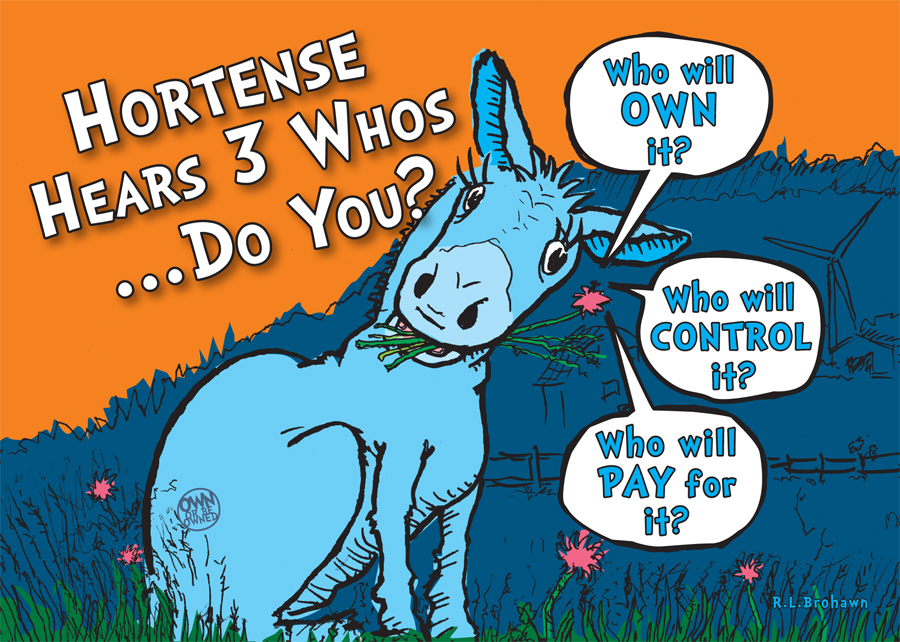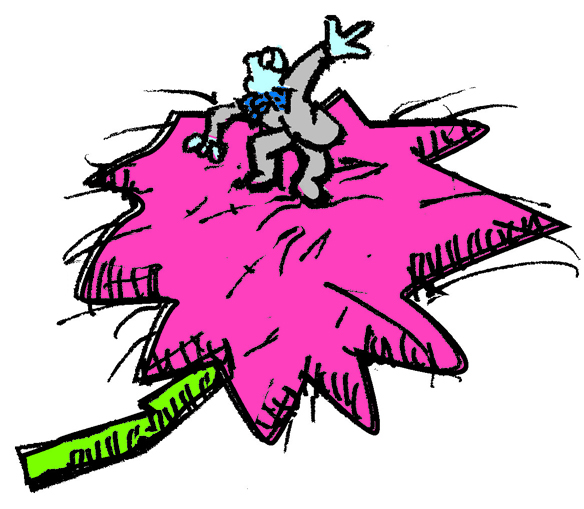Hortense the mule gets the message.
Politicians, think tanks and experts are proposing big plans for building new infrastructure, new green industries and new technologies that will produce the goods and services we buy.
When they present their proposals, we should always ask three questions:
Who will pay for it?
Who will control it?
Who will own it?
The one who has the money (or controls the money) to invest in things that produce wealth and income, will be the one who owns, controls, and enjoys the fruits of those things.
If new infrastructure, for example, is paid for using the past savings of the wealthy, Wall Street investments, government tax dollars or government debt, that’s who will own and control the new infrastructure, new green industries or new technologies. The vast majority of citizens will own no part of the new economic growth.
But there is one alternative that none of the politicians, big think tanks or experts have talked about. That is, we can pay for those big projects and enable every person to become an owner of the new productive things by applying sound business and banking principles.
This starts with a business seeking to add some new productive things (“capital”) in order to sell more of its goods and services to more customers. The business has to convince a lender or investor that the loan or investment is “feasible.” That means the new capital the business is adding must be able to generate (in a reasonable amount of time) enough future profits (“future savings”) to repay the loan or investment used to buy the capital.
A man named Louis Kelso invented something called an “Employee Stock Ownership Plan” as a way for workers in corporations to become owners of the companies they worked for. With access to self-repaying capital loans through an ESOP, employees have been able to buy up to 100% of their company, without using their personal savings or taking a pay cut.
Kelso pointed out that a similar approach could be used to turn every citizen, starting on the day they’re born, into an investor and direct owner of new productive wealth added to the economy.
Simply put:


How do you do that?
By financing economic growth in the private sector with insured capital loans and asset-backed money.
This new money and credit would be issued by the central bank (specifically, the twelve regional Federal Reserve banks) through local banks. It would be made available to tax-sheltered Capital Ownership Accounts set up for each citizen (just like Individual Retirement Accounts you set up at your bank).
Driven by the projected customer demand for new goods and services that businesses will produce, the new money and credit would only be created for financing new, citizen-owned capital (including land, infrastructure, buildings and job-displacing technologies like robots and artificial intelligence) added to the economy annually.
Within a transparent system of checks-and-balances, oversight, information sharing and accountability, every citizen every year would have equal access to the financial means to become an investor in the green technology frontier.
America, or any other nation that adopts this system, could grow the economic pie while simultaneously creating new owners of that new growth — and without taking away the wealth of existing owners. We call this process “economic democratization.”
So what’s the plan?
It’s called the “Economic Democracy Act.” This Act offers a set of monetary and tax reforms that build upon  powers that already exist in US federal law. These changes will grow a just, non-monopolistic free market economy, restore the private property rights of all owners, and limit the economic power of government.
powers that already exist in US federal law. These changes will grow a just, non-monopolistic free market economy, restore the private property rights of all owners, and limit the economic power of government.
But instead of only benefiting a tiny percentage of people, these changes will spread economic power through equal capital ownership opportunities to every citizen, throughout their lifetime.
Equal access to new asset-backed money and interest-free credit to buy productive capital is the equivalent in economics of what the ballot means in politics. With access to money power and the right kind of credit, every person — every year from the time of birth to the end of their life — could build up an independent source of income, increasing their personal liberty and well-being.
The Heart of America Project
An exciting project is taking root in Missouri, starting in some of the poorest areas in the city of St. Louis. The “Heart of America” Project is a strategic partnership between CESJ and Descendants of American Slaves for Economic and Social Justice (DAS4ESJ.org); and is based on state legislation signed into law by the governor of Missouri in 2022. It will introduce a proof-of-concept for democratizing capital ownership to every citizen (adult and child) and will serve as a major step toward a national Economic Democracy Act. To learn more and find out how you can help this initiative, go to https://www.cesj.org/wp-content/uploads/2024/04/HeartOfAmericaToEDA_Roadmap.pdf
Where can I get more information about the Economic Democracy Act (EDA)?
Here are some links to help you can learn more about the EDA:
> What the Economic Democracy Act is all about
> What the main features of the EDA would be
> How the EDA would benefit every citizen financially through equal capital ownership opportunities
Contact CESJ to learn more about the Economic Democracy Act and how you can help us spread this big idea around (especially to politicians).